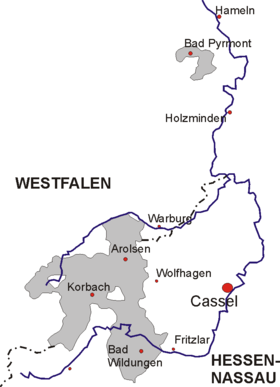County of Waldeck
| Principality of Waldeck and Pyrmont | ||||||||||
| Fürstentum Waldeck und Pyrmont | ||||||||||
|
State of the Holy Roman Empire, State of the Confederation of the Rhine, State of the German Confederation, State of the North German Confederation, State of the German Empire |
||||||||||
|
||||||||||
|
Anthem Waldecker Lied |
||||||||||
|
Waldeck (red) within the German Empire. The small northern territory is Pyrmont; the southern lands are Waldeck.
|
||||||||||
|
Map of Waldeck, showing the border between Westphalia and Hesse-Nassau
|
||||||||||
| Capital |
Waldeck (to 1655) Arolsen (from 1655) |
|||||||||
| Languages | German | |||||||||
| Government | Principality | |||||||||
| Historical era | Middle Ages | |||||||||
| • | Established as a County | 1180 | ||||||||
| • | Became Reichsgraf (immediate count) | 1349 | ||||||||
| • | Succeeded to Pyrmont | 1625 | ||||||||
| • | Raised to Imp. Principality | January 1712 | ||||||||
| • | Administered by Prussia, with autonomy |
1868 |
||||||||
| • | German Revolution | 1918 | ||||||||
| • | Subsumed into Prussia | 1929 | ||||||||
| Area | ||||||||||
| • | 1905 | 1,121 km² (433 sq mi) | ||||||||
| Population | ||||||||||
| • | 1905 est. | 59,135 | ||||||||
| Density | 52.8 /km² (136.6 /sq mi) | |||||||||
|
||||||||||

Coat of arms of Waldeck–Pyrmont (19th century)
The County of Waldeck (later the Principality of Waldeck and Principality of Waldeck and Pyrmont) was a state of the Holy Roman Empire and its successors from the late 12th century until 1929. In 1349 the county gained Imperial immediacy and in 1712 was raised to the rank of Principality. After the dissolution of the Holy Roman Empire in 1806 it was a constituent state of its successors: the Confederation of the Rhine, the German Confederation, the North German Confederation, the German Empire and, until 1929, the Weimar Republic. It comprised territories in present-day Hesse and Lower Saxony, (Germany).
Waldeck was a county within the Holy Roman Empire from about 1200. Its counts included Adolf II of Waldeck from 1270 to 1276. In 1655, its seat and the chief residence of its rulers shifted from the castle and small town of Waldeck, overlooking the Eder river and first mentioned in 1120, to Arolsen. In 1625, the small county of Pyrmont became part of the county through inheritance. In January 1712, the count of Waldeck and Pyrmont was elevated to prince by Charles VI, Holy Roman Emperor. For a brief period, 1805 to 1812, Pyrmont was a separate principality as a result of inheritance and partition after the death of the previous prince, but the two parts were united again in 1812. The independence of the principality was confirmed in 1815 by the Congress of Vienna, and Waldeck and Pyrmont became a member of the German Confederation. From 1868 onward, the principality was administered by Prussia, but retained its legislative sovereignty. Prussian administration served to reduce administrative costs for the small state and was based on a ten-year contract that was repeatedly renewed until Waldeck was formally absorbed into Prussia in 1929. In 1871, the principality became a constituent state of the new German Empire.
...
Wikipedia


